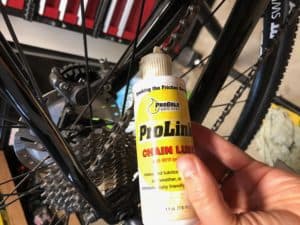- Shimano 105 vs Tiagra: Should You Upgrade? - January 6, 2020
- The Best Mountain Bike Grips for the Money + Complete Buying Guide - November 4, 2018
- The Best MTB Handlebars For Every Bike + Buying Guide - November 4, 2018
Your chain is the circulatory system of your bike – it transfers all the energy you put out into propelling the bike forward. Just like any other moving part, it requires lubrication of its hundreds of individual pieces.
The chain is entirely exposed to the elements, making it susceptible to contamination, corrosion, and drying out. Keeping your chain clean and lubed is a simple, but often overlooked process, so here is a quick guide to mastering chain lubrication, along with a few recommendations for the best chain lube for the job. Our top pick for lubing chains of all kinds is ProGold Prolink. It continually proves its mettle and has quickly become a workbench staple.
Chain Replacement
Before bothering to lube a chain that’s seen better days, check that the chain is worth the trouble. Replace the chain if it:
- is “stretched” beyond the point of no return,
- is badly corroded or rusted,
- has any damaged links.
When to Lube a Chain
The factory-installed lube in a new chain is probably the best lube it’s ever going to have and it all goes downhill from there. Continuing to treat your chain with fresh lube is a basic maintenance practice to make your chain last longer and work smoothly.
It’s advisable to lube your chain after washing your bike or riding in wet conditions. If the chain is squeaking, it’s past-due for lube! After some practice, you’ll remember to lube your chain every few rides to stay ahead of the dreaded squeaky chain.
Tools You Need
To lube a chain, gather the following supplies:
- bicycle chain lube
- a rag
That’s it. Seriously! To keep a chain clean and lubed, use the following technique:
- Lean the bike against a wall or in a work stand. Hold the tip of a chain lube bottle just above the chain anywhere on the bike (right over the rear wheel cassette is a good spot) and start turning the cranks backward, so the chain passes the tip slowly.
- Squeeze the lube bottle so that the lube is distributed onto the chain at about one drop per roller. Continue to until you have made one or two full passes on the chain.
- Let the lube soak in for a minute or two. The point is to get fresh lube inside the rollers.
- Wrap the rag loosely around the chain and use it to wipe away the excess lube. Turn the cranks in reverse so you can get the whole chain one segment at a time. The excess lube will take most of the grime with it. If the chain is excessively dirty, repeat the process until you can wipe with a fresh area of the rag can come away oily but not dirty. The outside of the chain should be relatively dry.
Safety tip: use caution near a moving drivetrain. Your sleeve or the rag can get caught, sucking your poor fingers into the sprocket and chain!
Deep Cleaning Methods

If you feel the need, you can use a spray-on degreaser to remove gunk from a chain, like the products from Finish Line Citrus, Simple Green WD-40. Soak the chain on the bike with a degreaser, scrub it off with a stiff brush like the Park GSC-1 (your most recently retired toothbrush will do the job as well), wipe off with a rag and apply chain lube.
Truly hardcore methods of getting every last bit of grunge out of your chain might include:
- Chain cleaning apparatus such as the Park CG-2.3 scrub and degrease the chain mechanically.
- Ultrasonic cleaners typically used for machine parts can vibrate every last bit of dirt off a chain, and some have been known to use a cheap denture or jewelry cleaner for the same purpose.
- The cheapest method is the old retired water bottle and dish soap water method. Drop your chain in an old water bottle half-filled with water and a drop or two of dish soap and shake the daylights out of it. Then remove, rinse, and dry your clean chain.
Always thoroughly dry a chain after using degreasers. Fresh chain lube isn’t going to do its job if the chain contains substances designed to do the opposite of allowing oils to stick to the chain.
Types of Bicycle Chain Lube
Wet vs dry:
Generally, dry lubes are better for dry conditions, where dust may be present to contaminate the chain. Wet lubes will last longer in the chain, but attract dust, so they are better for damp riding conditions.
Wax is commonly found in liquid lubes because it leaves a dense, dry coating on the chain.
Substances to Avoid
Many substances used as lubricants happen to make lousy bicycle chain lubes.
- Organic oils found in your kitchen will not stick to your chain long enough to help.
- Household oils like 3-in-1 oil and motor oil don’t stick to chains well enough to work.
- WD-40 is great for displacing water (it is, after all, “Water Displacement 40th formula”) but will leave your chain dry and squeaking in a short time.
- Spray-can lubes might make great lubricants, except they tend to get on everything, including your rims and brake pads.
The Best Bike Chain Lubes
Now that you’re confident with getting a chain clean and ready to lube, you need to choose from among dozens of options. Here’s a rundown of what works best for various conditions:
Best Lube for General Use
ProGold Prolink – All purpose chain lube that stays put and deflects dirt. A solid all-arounder for both road and mountain bikes.
Rock N Roll Gold – A solid compromise between Rock N Roll’s other lubes that works well in all conditions.
Best for Foul Conditions
Dumonde Tech – Dumonde brings their knowledge of motorsports to cycling with this lube that it claims will bond to the drivetrain components and stay there longer than most other lubes.
Muc Off – This wet lube is designed to penetrate deep into chains, keeping them running silky smooth, even in muddy cyclocross races.
Best for Dry Conditions
Boeshield T9 was originally developed by Boeing for aerospace applications and is perfect for degreased bicycle chains. It takes longer to apply properly but it’s worth the effort for aerospace performance.
Finish Line Dry – Shake up a bottle of this waxy lube, apply, and let dry. It leaves behind a waxy film that coats the chain for long-lasting results.
Best for Cold Weather
Squirt low-temp – Squirt formulated this lube to work in freezing temperatures, unlike other lubes that gum up chains when it gets cold. Get some for your snow-going fat bike or winter training bike.
Best Wax Treatment
Molten Speed Wax – the idea of stripping your chain and dipping it in melted paraffin wax is nothing new; riders have been doing this for decades. Molten’s dry pellets contain a proprietary blend of wax and lubricants to be melted in a small “crock pot” for a buttery-smooth treatment for high-performance bikes.


